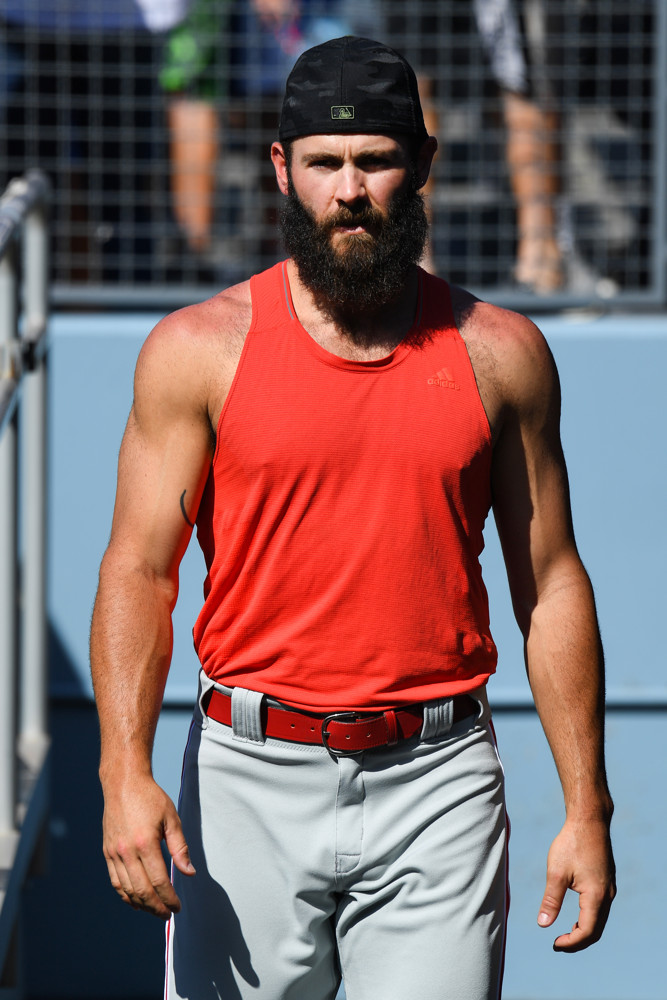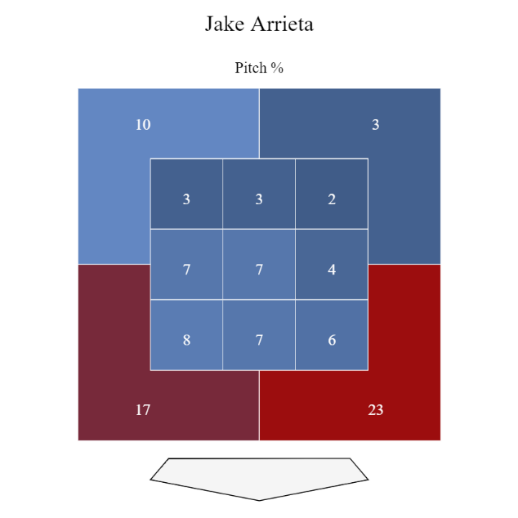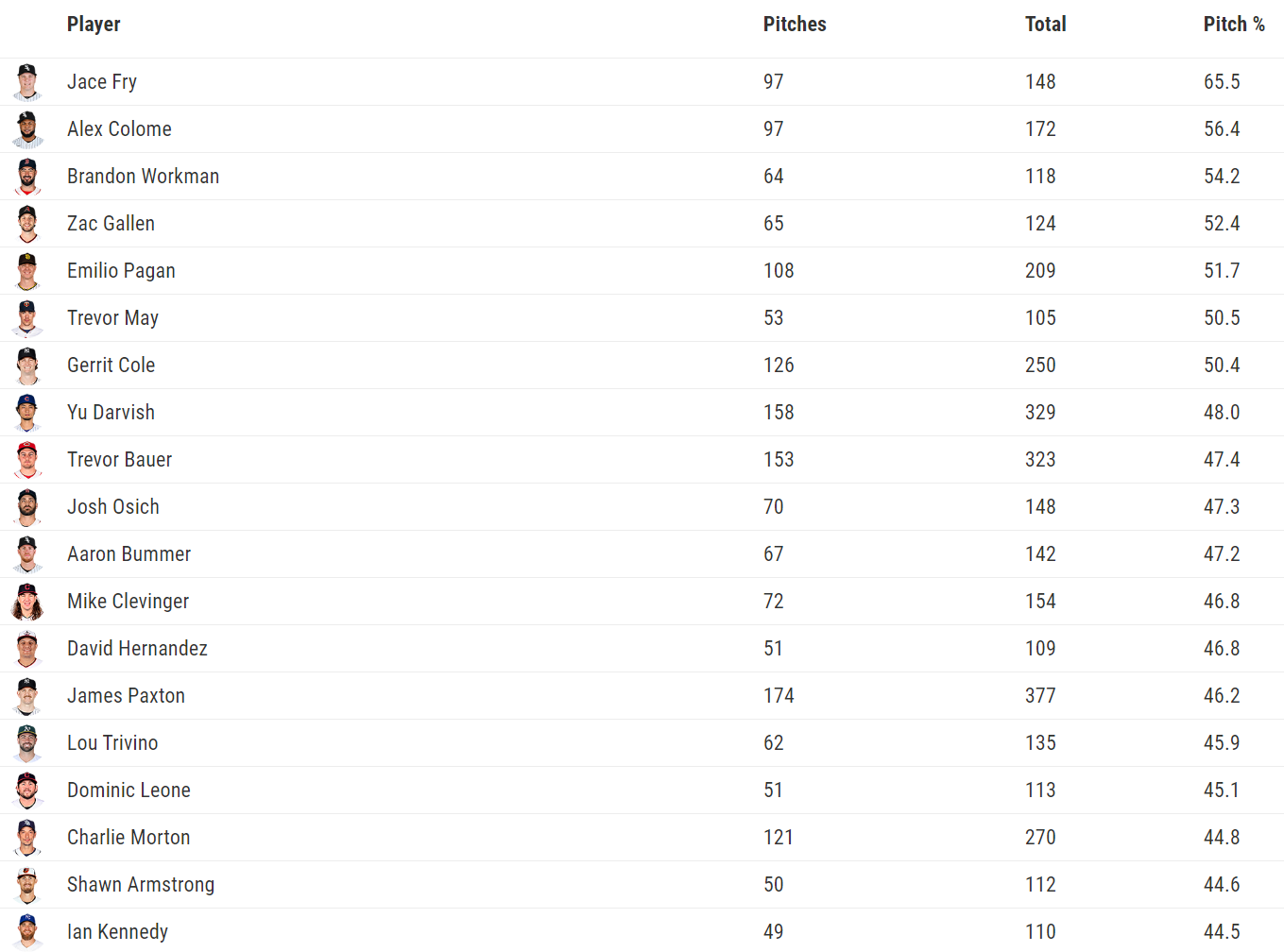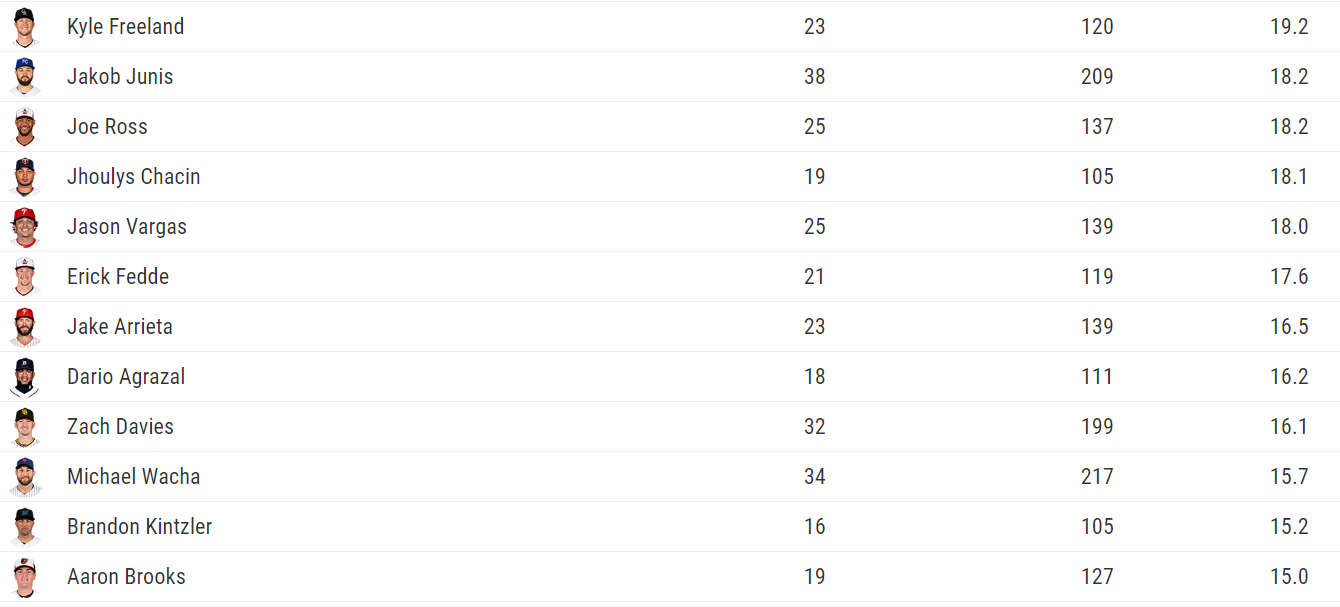Jake Arrieta is not the same pitcher he was with the Cubs. To be more direct, Arrieta has been one of the most hittable starting pitchers in the league over the past two seasons, which means he has also been one of the worst. I think we all can quickly all agree that Arrieta was not always in this position. As a member of the Cubs from 2014 to 2017, he was on top of the game.
| Sweet Spot% | Barrel% | Zone Whiff% | Chase Whiff% | Whiff% | |
|---|---|---|---|---|---|
| Jake Arrieta ‘19 | 33.8 | 6.8 | 12.4 | 29.7 | 18.3 |
| League Average ’19 | 33.0 | 6.3 | 17.0 | 40.4 | 24.3 |
| Jake Arrieta ‘16 | 31.4 | 4.8 | 17.5 | 42.3 | 25.2 |
The quality of contact he is allowing is not good, but it’s not as glaring as the steep drop in his ability to generate whiffs. That whiff% was in the fourth percentile of the entire league in 2019, which is not ideal for a guy holding a starting rotation spot on a team trying to win.
Arrieta had surgery at the end of last season to remove bone spurs in his elbow that he’d been pitching through. The pain caused him to basically eliminate the use of his slider (he calls it a cutter), throwing it just 18 times in his final six starts of 2019. When he did go to the slider in 2019, it was ineffective. The pitch turned into a 90 mph frisbee that batters—especially lefties—squared up often. The pitch netted hitters a .415 xwOBA overall, led by a .490 xwOBA mark from left-handed hitters.
Interestingly, Arrieta didn’t lose any velocity from the pitch as it actually went up a tick from the previous two years, but the movement and spin rates on the pitch were definitely lacking.
| Year | Usage | Velocity | Spin Rate | Inches of Break | Inches of Drop | xwOBA |
|---|---|---|---|---|---|---|
| 2018 | 23.6% | 89.4 | 2471 | 5.3 | 29.1 | .249 |
| 2019 | 12.7% | 89.7 | 2370 | 2.9 | 26.0 | .415 |
He told The Philadelphia Inquirer this spring “any time I oriented my hand in that position with the cutter (slider), the curveball, it shortened my outing even more because of the swelling and the pain in the elbow.” Arrieta says the injury impacted his ability to throw his curveball as well, but the numbers don’t tell the same story.
| Year | Usage | Velocity | Spin Rate | Inches of Break | Inches of Drop | xwOBA |
|---|---|---|---|---|---|---|
| 2018 | 10.2% | 80.7 MPH | 2776 | 13.5 | 55.7 | .280 |
| 2019 | 13.9% | 80.6 MPH | 2770 | 13.7 | 54.7 | .226 |
It’s interesting that he was able to pitch through the pain with his curve and produce nearly identical velocity, spin, and movement while getting better results on the pitch compared to 2018 while his slider turned into a pumpkin.
In the same interview from The Philadelphia Inquirer, Arrieta said “performing well or not, I’m doing everything I can to control the way I prepare and take care of myself to the best of my ability. If I’m able to do that and stay healthy, the performances will be good.” It sounds good and reasonable when he says it, but unfortunately, it’s just not that simple. Being healthy and in shape does not mean a pitcher will have good results on the mound. I can understand how Arrieta may not be willing to accept this considering his notable physical conditioning has helped get him this far as a successful professional baseball player, but it’s time to face reality. He just can’t throw as hard as he used to, and he’s in line with the aging curve for almost every other pitcher through his mid-thirties. We can see it in his sinker, which he leans on as his primary pitch.
Raise your hand if you see any red flags below:
| Year | Age | Usage | Velocity | Whiff% | xwOBA |
|---|---|---|---|---|---|
| 2015 | 29 | 32.5% | 95.3 MPH | 14.4% | .271 |
| 2016 | 30 | 44.3% | 94.5 MPH | 18.0% | .315 |
| 2017 | 31 | 62.0% | 92.1 MPH | 14.7% | .319 |
| 2018 | 32 | 53.8% | 93.0 MPH | 13.2% | .334 |
| 2019 | 33 | 54.5% | 92.4 MPH | 10.2% | .358 |
(assumes millions of hands are raised)
Arrieta’s sinker has achieved a game average velocity of 94+ MPH in just two percent of his starts since the 2017 season. In 2015 and 2016 he averaged 94+ MPH on his sinker in 86% of his starts with many of those in the 95-96 range. Right-handed pitchers who want to be paid to play baseball in the majors today need a fastball that sits at or above 94 MPH unless they have some great secondary pitches to go along with above average command. Unfortunately, Arrieta has average secondary pitches and command and he’s lost a few ticks on his fastball. While the whiff rate on it is still above league average for two-seamers (6.7% in 2019), it’s not enough to buoy him.
So Where Do We Go From Here?
Arrieta is in danger of having 2020 be his final year in the majors. Even if he shows up in 2020 as a 2016 version of himself, when he accrued 3.5 fWAR, it likely still won’t be enough for the Phillies to pick up his 2021/2022 options at $20 million apiece. There isn’t much of a market for starters of his current caliber. Is it possible he gets a one-year minor league “prove it” deal from someone like Atlanta gave Felix Hernandez this offseason if he bounces back a little in 2020? Probably. But what are the chances he doesn’t prove anything and his career ends in 2021?
Is there hope for Jake Arrieta? Can he flip the script and extend his career to remain a useful pitcher into his late thirties? He’s probably going to have to make some changes as he’s working against the clock just to stay afloat. The changes outlined below aren’t easy on one’s pride, but they could be relatively simple to execute because they don’t require learning a new pitch or mechanics or adopting a more intense training regimen.
Move to the Bullpen—This Year
I’m going to lead with this one because it is going to be the biggest factor in extending Arrieta’s career. He just won’t survive in the league as a right hander with a 91-92 MPH sinker without great secondary pitches and command, so just adjusting his approach or pitch mix will not suffice. His spring training results in 2020 indicate that he didn’t make any major changes to his approach or command in the offseason.
That leaves us with the requirement for Arrieta to recover a few ticks on his fastball, which is doable if he moves to the bullpen. I’m not talking about moving to the bullpen to be the swing guy or long man putting up three or four-inning outings. I don’t think that will do the trick. Arrieta needs to go full Ian Kennedy and limit himself to 1-2 innings as a high-leverage reliever to focus on regaining some lost velocity. Let’s take a look at some recent starters turned high-leverage relievers who are currently in Major League bullpens and the gains they realized on their fastball velocities with the switch:
| Pitcher | Final Year as SP | First Year as RP | Difference |
|---|---|---|---|
| Brandon Workman | 90.4 MPH | 92.3 MPH | +1.9 MPH |
| Daniel Hudson | 92.8 MPH | 96.1 MPH | +3.3 MPH |
| Archie Bradley | 92.4 MPH | 96.4 MPH | +4.0 MPH |
| Wade Davis | 92.1 MPH | 95.7 MPH | +3.6 MPH |
| Ian Kennedy | 91.9 MPH | 94.5 MPH | +2.6 MPH |
| Jake Arrieta | 92.5 MPH | ??? | ??? |
It’s reasonable to expect Arrieta to gain 2-3 MPH by following the lead of the guys on this list which would get him back in the 94-96 MPH range. This is a huge deal! Arrieta relied on his big velocity during his best years to support and complement his average secondary pitches. If he can return to a higher velocity with his fastball, all his secondary offerings will benefit as well, just like they did when he was sitting at 94-96 MPH with the Cubs.
Why else does Arrieta make sense as a late inning guy? Well, he looks the part. This may sound trivial, but it’s not a coincidence that some of the best closers in the game have had “the look” that puts a little bit of fear in the eyes of the hitter. Add in the injuries he’s battled over the past few years, and the move seems like a great formula to keep Arrieta healthy and improve his performance.

(Photo by Brian Rothmuller/Icon Sportswire)
Would the Phillies go for it this year?
They should. Arrieta is on track to continue to lose velocity this year as a starter, which will make him even more hittable. Jake Arrieta as a member of the starting rotation will be a liability. I know it’s a tough move to put (a pro-rated) $20 million in the bullpen, especially in a short season where he may only pitch 20-30 innings, but the Phillies should absolutely consider it.
Arrieta has a history of large splits based on batter handedness, and a relief role could allow the team to be more strategic about getting him in against a string of right-handed hitters. In 2019, Arrieta faced left-handed hitters 48% of the time in 2019 while the league average for right-handed pitchers was about 45%. As a reliever, the Phillies would have the luxury of playing the match ups to limit his exposure to left-handed hitters. Right-handed relievers faced left-handed hitters only 42% of the time in 2019, so dropping his match up rate against lefties to 40% is achievable. Even with extended rosters and new rules for 2020, relievers should still have better match ups than starters relatively speaking.
Another good reason for the Phillies to give this a shot is they have a lot of question marks in their current bullpen. David Robertson and Seranthony Domínguez are out for the year with injuries, while Hector Neris and Tommy Hunter reported to camp only a week before the first game due to COVID-19. Ranger Suarez is still missing from camp and has been placed on the COVID-19 injured list. Assuming they’ll all be okay for most of the season after a late start, there are still a lot of questions in the bullpen. Phillies relievers are expected to accrue 1.0 fWAR in 2020, which is 18th in the majors. Teams are expected to rely on their bullpens more than ever this year and a group in the bottom half of the league with injury and depth questions is not an ideal approach for a team looking to compete for a playoff spot.
Their starting rotation is not swimming in depth and proven talent either. Considering Arrieta is projected below one WAR this season by some systems, however, there are other options that can fill his role and get the same or better result while gaining valuable experience as a starting pitcher. A move like this would also be a long-term investment by giving the rotation spot to a younger pitcher who has a potential future with the Phillies. Consider the rotation below sans Arrieta:
| Player | Starts |
|---|---|
| Aaron Nola | 12 |
| Zack Wheeler | 12 |
| Vince Velasquez | 12 |
| Nick Pivetta | 10 |
| Spencer Howard | 10 |
| Zach Eflin | 4 |
Zack Wheeler’s wife gave birth during the season which may have impacted his status, but Wheeler is on target to start the third game of the season and stay with the team. Confirming his status as a full participant in the season is an even stronger reason for the Phillies to make this change.
Velasquez and Pivetta have both received positive reviews this spring and summer due to new pitch and mechanical developments, so I can see them taking a real step forward in the rotation. Spencer Howard will be called up in early August and should be a strong contributor upon his arrival. That leaves Zach Eflin as the most likely to produce results below replacement level as a starter, which is okay considering he’s just the emergency/spot start guy. If he doesn’t look like a viable option or if there are injuries to the starting five, the Phillies still have Cole Irvin, Ranger Suarez, and Enyel De Los Santos available to make a few spot starts—especially early in the season with the luxury of expanded rosters.
Would Arrieta go for it this year?
Maybe. Again, acknowledging that his career as a starting pitcher is likely over is tough, and he seems like a guy who is used to working hard to find the success and the role he wants. There is a benefit for proving himself as a viable reliever this year. Even if he bounces back in 2020, the likelihood of him landing a lucrative major league deal in free agency as a starter is unlikely.
If he decides to declare himself a reliever in the offseason, it’s also unlikely he will fetch any real guaranteed money without having shown he can do it. Arrieta has started every single game he has appeared in since 2013. Let’s say he ends up as the Phillies closer in September and shows improved velocity and success in the role. As a 34-year-old known for his mental and physical conditioning, he could very well fetch a multi-year guaranteed deal with a major league club as a late inning reliever.
This will almost certainly not be the case if he continues as a starting pitcher.
Adjust the Arsenal
A common exercise for starters moving the bullpen is to evaluate their pitch mix and reduce their total number of offerings to feature only their above average pitches since they usually only face hitters once per game. With Arrieta, I’m skeptical that his slider will come back to it’s pre-2019 form, but if it does, then it is a worthwhile pitch to use against right-handed hitters. The main opportunity I see with his arsenal is the way the pitches are deployed against right and left-handed hitters.
| Pitch | 2018 | 2019 |
|---|---|---|
| Sinker | 58.70% | 58.70% |
| Curve | 7.60% | 13.20% |
| Slider | 25.50% | 13.10% |
| Changeup | 6.00% | 13.70% |
| Pitch | 2018 | 2019 |
|---|---|---|
| Sinker | 47.90% | 50.20% |
| Curve | 13.20% | 14.60% |
| Slider | 11.70% | 12.20% |
| Changeup | 10.80% | 22.40% |
The biggest recommendation I have is to eliminate the use of the slider against left-handed hitters and redistribute those pitches between his curve and changeup. Arrieta’s changeup is a great new weapon that he’s developed over the past few years, and his slider has had little effectiveness against left handed hitters. Although he’s hinted that he hasn’t had a consistent feel for the pitch, the results have been above average. Plus, the changeup is easier on his elbow which could help prevent future injuries if he increases its usage. Additionally, if he’s able to get a few ticks back on his sinker, the changeup should be even more effective with greater separation in velocity. The changeup currently sits at 87.5 MPH on a 92.5 MPH fastball, which isn’t ideal.
Adjust the Approach
What’s one thing we’ve learned about fastballs over the past few years? Elevate them to get swings and misses and to change the eye level of the hitter to set up the low breaking stuff. But remember, Arrieta primarily throws a two-seamer, which doesn’t necessarily play well up in the zone. Here is Arrieta’s pitch location chart per pitch type from 2019.

That’s a lot of white space at and above the top of the zone! If I’m a hitter facing Jake Arrieta, I’m focusing middle and low and basically eliminating the top of the zone based on this. Here’s another breakdown:

Allowing hitters to focus middle-low by not attacking the top of the zone is not a sound approach in today’s game. The results are clear as he did not fool many hitters in 2019 with this strategy. An overall whiff rate in the fourth percentile means he isn’t fooling anybody. Even going out of the zone, his two-seamer only generated a 20.5% whiff rate.
For reference, here are the leaders on whiff rates on fastballs out of the zone in 2019:

Not many surprises here. We have a bunch of guys known for their good fastballs and we even see a few of our converted starters on this leaderboard in Workman and Kennedy.
Here’s the bottom of the list for pitchers with at least 100 qualifying pitches (fastballs out of the zone) in 2019:

This is not a group you want to be a part of. Honestly, a few of the other guys on the part of the list should consider a bullpen move, too—Kyle Freeland, Jakob Junis, Jhoulys Chacin, and Erick Fedde fit the mold of guys who know how to pitch but have fastballs sitting in the 90-92 MPH range and could really thrive in a bullpen role. Zach Davies can keep his role while he floats between framing experts as battery mates and as long as home plate umpires are still humans.
Jake Arrieta has made major adjustments before—don’t forget he had the highest ERA of any Orioles starting pitcher with a minimum of 60 starts since 1954 before he was traded to the Cubs. In 2013, Arrieta publicly contemplated retirement and walking away from the game because his results were so bad. But a change of scenery brought adjustments and dramatic improvements.
In a 2016 interview with Sports Illustrated, Buster Posey reviewed Arrieta’s slider/cutter by saying “It’s a closer’s cutter…except for eight or nine innings, not one.” There’s a reason most guys who throw like that can’t go more than one inning, and Arrieta has fought off Father Time longer than most.
Here’s to hoping we see a reinvented Jake Arrieta contributing to his team’s success in 2020 and beyond.

Awesome article, Chet. Great read!
Thank you!
You wrote all this for what reason? Because everyone is disappointed you didn’t get the job instead Arietta? Critics and armchair wannabe. Of course he’s not the same pitcher. Lets see you pitch every 5 days in a 162 game season for years see how you do. Then you can criticize until then watch the game.
Thanks for reading!
Didn’t read the entire long winded piece of how much you think you know about baseball. Go to a fantasy camp where they have you play 10 days of doubleheaders in a row. Actually talk to a pro pitcher or position player and learn something about love of the game and the work they put in. Stats is all you young critics spew. Stats are meant for gm’s baseball operations scouts. You use them as a weapon to down the very players that provife you not only entertainment but apparently a useless job that kills the spirit of baseball. At least real reporters researched the man gathered facts related to his performance. Pitchers especially. Your first mention of he’s not the same pitcher is the most overused cliche ignorance laced comment in the history of internet look what I know articles. Let’s face it you’re not a sports reporter. You a glorified internet statistician who knows nothing about loving the game and all it takes to live the grind of a 162 game season and the toll it takes on the human body.
Hey, yeah. Good points! I am not a sports reporter, and I write about baseball as a hobby. I do know quite a bit about the game and follow it religiously, but I’ll be the first to admit I still have plenty to learn.
My goal is to share what I have learned and what I’m still learning with others to help bring them along or spark interesting discussions about the sport. This is also my first article :) Thank you for the feedback!!
Feel free to reach out directly if you have any other notes, and I encourage you to read my full article as the goal was to offer a situation where this player, who is no longer a top performer, could regain that status for a few more years before he calls it quits.
Thanks again for skimming/commenting.
I read the point of your article to move someone a philly fan thinks to the bullpen. I use fan loosely as philly is known for chucking batteries from the stands at who they determine are traitors. (J.D.Drew) Again, how joe got the manager’s job when they could’ve had you on the cheap is a mystery. Religion is overrated try learning about what baseball means not what mindless discussion about what you and the other religious followers of stats and all the moves they’d make in a game differently. Save that for fantasy baseball sausage fests in your friends living room so he can escape his wife for a night. Try watching the game in awe of the talent discipline and heart it takes to be an athlete. Thx for your cutsie little ego driven skimming comment. Cute but predictable. Don’t give up your day job.
Thx for playing.